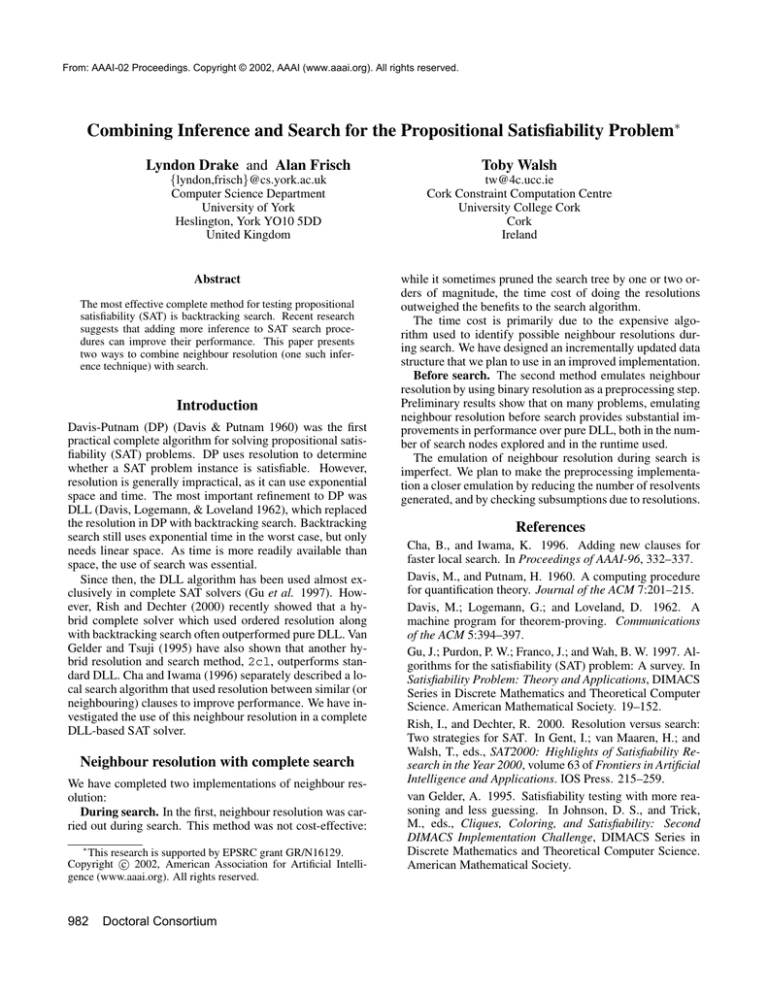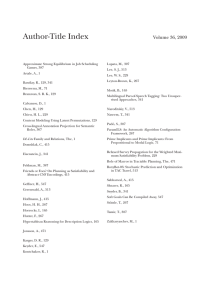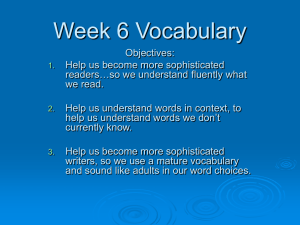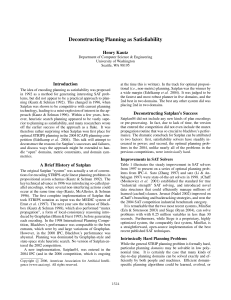
From: AAAI-02 Proceedings. Copyright © 2002, AAAI (www.aaai.org). All rights reserved.
Combining Inference and Search for the Propositional Satisfiability Problem∗
Lyndon Drake and Alan Frisch
{lyndon,frisch}@cs.york.ac.uk
Computer Science Department
University of York
Heslington, York YO10 5DD
United Kingdom
Abstract
The most effective complete method for testing propositional
satisfiability (SAT) is backtracking search. Recent research
suggests that adding more inference to SAT search procedures can improve their performance. This paper presents
two ways to combine neighbour resolution (one such inference technique) with search.
Introduction
Davis-Putnam (DP) (Davis & Putnam 1960) was the first
practical complete algorithm for solving propositional satisfiability (SAT) problems. DP uses resolution to determine
whether a SAT problem instance is satisfiable. However,
resolution is generally impractical, as it can use exponential
space and time. The most important refinement to DP was
DLL (Davis, Logemann, & Loveland 1962), which replaced
the resolution in DP with backtracking search. Backtracking
search still uses exponential time in the worst case, but only
needs linear space. As time is more readily available than
space, the use of search was essential.
Since then, the DLL algorithm has been used almost exclusively in complete SAT solvers (Gu et al. 1997). However, Rish and Dechter (2000) recently showed that a hybrid complete solver which used ordered resolution along
with backtracking search often outperformed pure DLL. Van
Gelder and Tsuji (1995) have also shown that another hybrid resolution and search method, 2cl, outperforms standard DLL. Cha and Iwama (1996) separately described a local search algorithm that used resolution between similar (or
neighbouring) clauses to improve performance. We have investigated the use of this neighbour resolution in a complete
DLL-based SAT solver.
Neighbour resolution with complete search
We have completed two implementations of neighbour resolution:
During search. In the first, neighbour resolution was carried out during search. This method was not cost-effective:
∗
This research is supported by EPSRC grant GR/N16129.
c 2002, American Association for Artificial IntelliCopyright gence (www.aaai.org). All rights reserved.
982
Doctoral Consortium
Toby Walsh
tw@4c.ucc.ie
Cork Constraint Computation Centre
University College Cork
Cork
Ireland
while it sometimes pruned the search tree by one or two orders of magnitude, the time cost of doing the resolutions
outweighed the benefits to the search algorithm.
The time cost is primarily due to the expensive algorithm used to identify possible neighbour resolutions during search. We have designed an incrementally updated data
structure that we plan to use in an improved implementation.
Before search. The second method emulates neighbour
resolution by using binary resolution as a preprocessing step.
Preliminary results show that on many problems, emulating
neighbour resolution before search provides substantial improvements in performance over pure DLL, both in the number of search nodes explored and in the runtime used.
The emulation of neighbour resolution during search is
imperfect. We plan to make the preprocessing implementation a closer emulation by reducing the number of resolvents
generated, and by checking subsumptions due to resolutions.
References
Cha, B., and Iwama, K. 1996. Adding new clauses for
faster local search. In Proceedings of AAAI-96, 332–337.
Davis, M., and Putnam, H. 1960. A computing procedure
for quantification theory. Journal of the ACM 7:201–215.
Davis, M.; Logemann, G.; and Loveland, D. 1962. A
machine program for theorem-proving. Communications
of the ACM 5:394–397.
Gu, J.; Purdon, P. W.; Franco, J.; and Wah, B. W. 1997. Algorithms for the satisfiability (SAT) problem: A survey. In
Satisfiability Problem: Theory and Applications, DIMACS
Series in Discrete Mathematics and Theoretical Computer
Science. American Mathematical Society. 19–152.
Rish, I., and Dechter, R. 2000. Resolution versus search:
Two strategies for SAT. In Gent, I.; van Maaren, H.; and
Walsh, T., eds., SAT2000: Highlights of Satisfiability Research in the Year 2000, volume 63 of Frontiers in Artificial
Intelligence and Applications. IOS Press. 215–259.
van Gelder, A. 1995. Satisfiability testing with more reasoning and less guessing. In Johnson, D. S., and Trick,
M., eds., Cliques, Coloring, and Satisfiability: Second
DIMACS Implementation Challenge, DIMACS Series in
Discrete Mathematics and Theoretical Computer Science.
American Mathematical Society.








